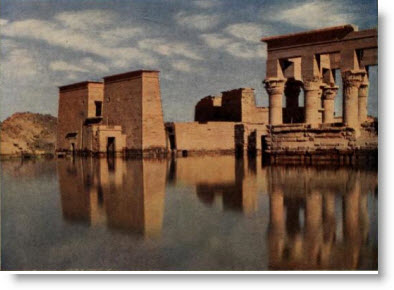Ancient Egypt

Ancient Egypt (the ruins of Philae)
The civilization of Ancient Egypt lasted for millennia and underwent many cultural and political changes. Its history is so long, that it is convenient to speak of different eras or epochs to differentiate between the different phases in the history of ancient Egypt.
The Old Kingdom refers to a period in the history of Ancient Egypt, which was regarded by the ancient Egyptians themselves, in later periods, as the golden age of their civilization. It is indeed the longest period of political stability that ancient Egypt has ever known.
During the era of the Old Kingdom, the Egyptian civilization became centralized and there was increased prosperity, which allowed for significant artistic and architectural developments. The great themes of classical Egyptian literature Egyptian, and the artistic canons of painting and sculpture have their roots during this golden age. It was also during this period that the Egyptians made improvements to the administrative system that would last almost three millennia.
The Old Kingdom covers a period of five centuries (from about -2700 to -2200) and consists of four dynasties:
- Third Dynasty (-2700 to -2620)
- Fourth Dynasty (-2620 to -2508)
- Fifth Dynasty (-2508 to -2350)
- Sixth Dynasty (-2350 to -2200)
During the Old Kingdom, the ancient Egyptians began building pyramids for the first time: first the pyramid at Saqqara, in the reign of King Djoser, and later the three monumental pyramids on the Giza plateau (those of Khufu, Khafre and Menkaure). The construction of pyramids and other large monuments reflects the improved social and political organization of Egypt which allowed the rulers to organize large groups of people for public works. It also reflects the rise in prosperity; without a surplus of food and other resources it would not have been possible to divert the armies of workers and artisans needed to build the temples, pyramids and monuments, away from the tasks of growing food.
The Old Kingdom was also a period of territorial expansion. During this time, the civilization of ancient Egypt spread beyond its cradle along the Nile river valley and into Sinai (which it conquered around 2650 B.C.) and into Nubia (which it conquered around 2300 B.C.)
The Old Kingdom is often considered as a period of closure against outside cultural influences. But this relative isolation did not prevent the flowering of the Pharaonic civilization. During the Old Kingdom nobles and notables were buried in mastaba with lavish furnishings, even if the pomp of burial practices did not reach its peak until the New Kingdom.
The capital is located in Memphis, at the southern tip of the Nile delta. The principal gods are Ptah, patron of craftsmen, who created the universe and the sun god Ra. The pharaohs were buried in the royal necropolis of Saqqara, near Memphis, and Abydos, Holy City of Wennefer-Osiris in Upper Egypt. The first traces of the Pyramid Texts were found at Saqqara date from the reign of King Unas (c. -2350).
The end of this period is marked by the rise of nomarchs and local princes which led to a weakening of the central power during the long reign of Pepi II. So began a relative decline that would lead to the invasion of the delta by an Asian people.
pyramids Egypt Mummies Search Engines Link Report
Egyptian Cities | Egyptian Education | Ancient Egypt | egyptian clothing | Egyptian Houses | The Egyptians | Egyptian Family Life | Egypt and its Neighbours | Government in Ancient Egypt | Egyptian History | Military | Organization of Ancient Egypt | Recreation | Egyptian Religion | Egyptian Gods | Pyramids | About | Privacy Policy | Site News | Site Map
EgyptPast.com - Facts and Information About the History of Ancient Egypt
-